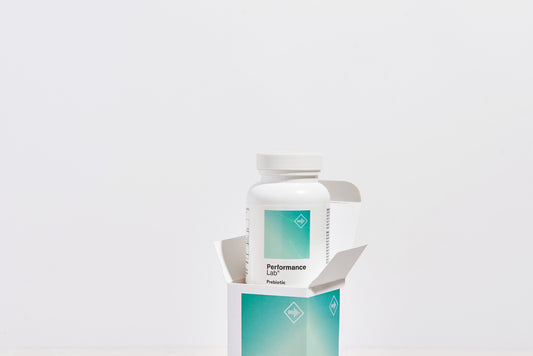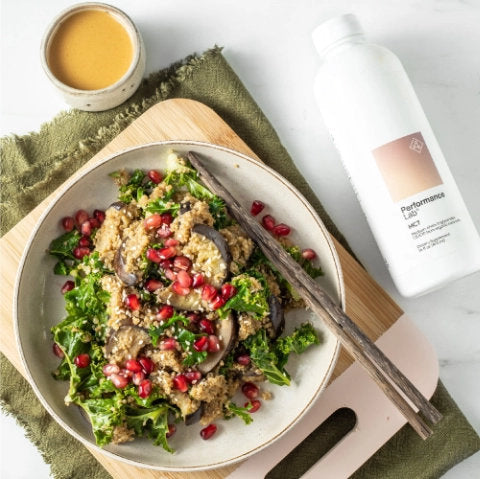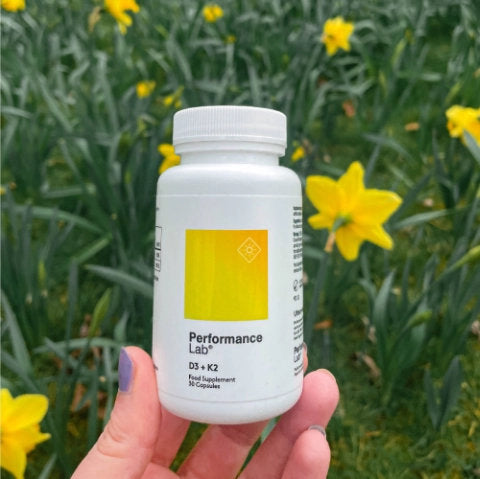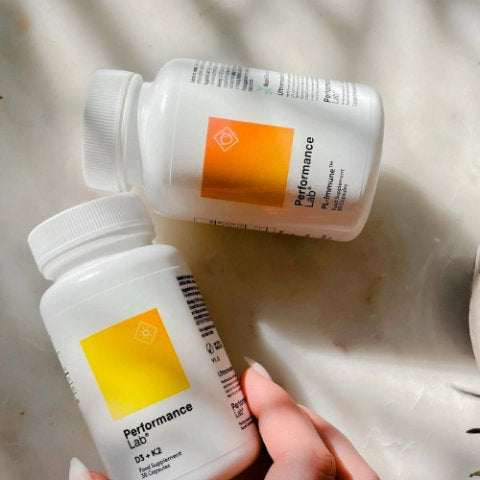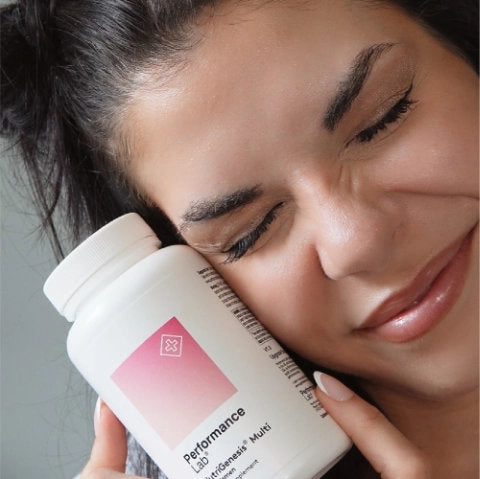Probiotics have hit mainstream media hard in recent years.
Whether it’s a new healthy gut shot, yogurt, or probiotic supplement, you've likely heard all about how probiotics can support a healthy digestive system(1) by introducing beneficial bacteria into the gut.
These live bacteria, also known as friendly flora or healthy gut bacteria, have been praised for their ability to support digestion, boost nutrient absorption(2), and enhance immune function.(3)
But while probiotic supplements have been the go-to for optimizing the gut microbiome, an arguably more effective solution is available to us: prebiotics.
Prebiotic fibers and supplements may be a better way to promote a thriving microbiome.
Unlike probiotic supplements, which introduce live bacteria into the gut, prebiotics act as fuel for these beneficial bacteria, helping them thrive and creating a healthier, more balanced microbiome.
Choosing the right prebiotic supplement can provide a significant upgrade to enhance gut health and support healthy digestion, immune function, and even the gut-brain axis.(4)
Let's explore why prebiotics are becoming the key to unlocking a healthier microbiome in 2025 and beyond.
Why Prebiotics And Not Probiotics?

Both prebiotics and probiotics play important roles in supporting gut health, but prebiotics are increasingly being recognized as the more reliable option. Especially when it comes to consistency and effectiveness.
While probiotics introduce live bacteria into the gut, they face several challenges that can limit their potential:
1. Probiotic supplements are fragile.
Probiotics are sensitive to external conditions like heat, cold, light, and time, which can degrade their potency.(5) They also need to reach the colon alive in order to deliver their health benefits.(6)
Unfortunately many probiotic strains are destroyed by stomach acids on their journey down the gut. Meaning they never make it far enough to carry out their good work.
2. Probiotic labeling can be misleading.
Probiotic supplements often advertise high colony forming unit (CFU) counts. This is the number of bacteria in the capsule. CFU counts can range from millions to 50 billion probiotics per serving. But these numbers don’t always reflect the number of live bacteria that actually reach your gut.
Plus, more isn't always better.
Did you know: Manufacturers list CFU (live probiotics)(10) at the time of manufacture. But that count can drop a lot by the time we consume them. 10 billion CFU listed on the label might mean 5 billion live and 5 million dead.
According to the US National Institutes of Health (NIH), probiotic supplements with higher CFU counts do not necessarily improve a product's health effects.(7)
3. Digestive side effects are possible
For some, especially those with sensitive stomachs, high doses of probiotics can lead to digestive discomfort like gas, bloating, or even constipation.
The benefits of prebiotics

Probiotics aren't bad, they're just less stable. And it's harder to see what is in a good probiotic. How do you know if the bacteria are live? And if they are, will they survive to the colon?
Prebiotics, on the other hand, avoid many of these challenges. Rather than introducing live bacteria, prebiotics serve as nourishment for the beneficial bacteria already present in your gut, helping them flourish naturally.
By providing a steady source of fuel, prebiotics ensure a healthier, more balanced gut microbiome without the concerns over bioactivity, strain survival, or digestive upset.
Enter the prebiotic supplement.
What Exactly Are Prebiotics?
Prebiotics are indigestible fibers that nourish growth of beneficial microorganisms in the intestines and colon. They are found in foods and supplements.
Prebiotic dietary supplements are gaining traction in this market because not only can they boost the microbiome like probiotic supplements do – but ultimately, they do it in a more reliable, organic and comfortable way.
Instead of bombing the gut with billions of mixed-strain microbes, prebiotics feed your existing microbiome for robust growth and thriving health.
Prebiotics are also a 2-in-1 supplement.
Beyond boosting the microbiome, prebiotics supply soluble fiber that contributes to ideal daily fiber intake.
We know that getting enough daily fiber is key for digestion. But it also supports the body in other ways:(8)
- Digestive health and comfort
- Heart and cardiovascular health
- Blood sugar balance
- Appetite control
- Healthy weight management
By optimizing the microbiome and boosting your soluble fiber intake, prebiotic supplements offer benefits that probiotics do not.
Usage Tip: When taking a Prebiotic fiber supplement, experts recommend taking 25-30 g of fiber per day from diet, including both soluble and insoluble fiber alongside your supplement.(9)
Types of Prebiotic Fibers
There are various types of prebiotics, including inulin, fructooligosaccharides (FOS), galactooligosaccharides (GOS), and resistant starch.
Different types of fibers nourish different strains of beneficial bacteria, so the choice of prebiotic can affect which bacteria flourish in your gut.
Source of Prebiotics

Prebiotics can be derived from various sources, such as chicory root, acacia gum, green bananas, or even synthetic fibers. Naturally derived prebiotics may offer additional health benefits, while synthetic versions might focus solely on feeding bacteria.
Solubility and Digestibility
Some prebiotics are more easily digested than others. Soluble prebiotics, like inulin, dissolve in water and can be fermented by gut bacteria, whereas insoluble fibers may pass through the digestive system with minimal fermentation. This difference affects how quickly the prebiotic works and its impact on digestion.
For the best prebiotic benefits, you need the most effective ingredient presented in the cleanest supplement format.
Let’s get right to the best prebiotic ingredient, followed by the best prebiotic supplement.

What Ingredients Should I look For in a Quality Prebiotic?
When choosing a prebiotic supplement, two key ingredients stand out: Inulin and Fructooligosaccharides (FOS).
Inulin and fructooligosaccharides (FOS) are two types of soluble fibers found in one natural source: Chicory root. Let's explore why chicory, specifically Orafti® Synergy1, is the gold standard in prebiotics.
Why Choose Chicory Root?

Chicory root is a natural source of inulin and FOS, two powerful soluble fibers. The unique benefit of chicory root is its resistance to digestion. Thanks to its special structure of short-chain and long-chain fibers, chicory-derived prebiotics like Orafti® Synergy1 are highly resistant to digestive enzymes and stomach acids. This means they make it through your digestive system completely intact, arriving in the colon ready to work.
In other words, chicory ensures the prebiotic fibers get where they need to be, for optimal nourishment of your gut microbiome.
What Makes Orafti® Synergy1 Special?
Orafti® Synergy1 is a bioengineered form of inulin-FOS, specially designed for maximum microbiome benefits. Unlike standard prebiotics, Orafti® Synergy1 offers a 2-in-1 advantage, combining the fiber benefits of inulin with the enhanced prebiotic power of FOS.
But what really sets Orafti® Synergy1 apart is its ability to selectively nourish one specific probiotic genus: Bifidobacterium(11).
Why Focus on Bifidobacterium?
You might wonder, why boost Bifidobacterium if it’s not the most prevalent probiotic in the gut? The answer is simple: Bifidobacterium is a probiotic powerhouse.
Bifidobacterium strains are considered among the most important for maintaining a healthy gastrointestinal tract(12).
They are highly competitive and can feed on a wider variety of nutrients compared to other bacteria. This adaptability allows them to thrive and outcompete harmful bacteria, and shift the microbiota balance favorably(13). Making them essential for supporting long-term gut health.
In short, while Bifidobacterium may not dominate your gut microbiome in sheer numbers, it’s one of the most resilient and beneficial type of bacteria you can support. And that’s where Orafti® Synergy1 comes in—helping to fuel these probiotic champions and ensure a balanced, healthy microbiome.
Benefits of Orafti® Synergy1 for Gut Bacteria
Digestive health

Orafti® Synergy1 is widely recognized for its ability to nourish Bifidobacterium and provide essential soluble fiber support, making it a standout ingredient for promoting overall digestive health. Here’s how it benefits your gut:(14,15)
- Contribute to normal bowel function by increasing stool frequency
- Stimulate fermentation processes in the gut that increase stool volume and softness
- Assist with easy and comfortable elimination
- Support a resilient gut lining and reduce leaky gut risk
- Promote a healthy and balanced digestive system
- Provide digestive support that comes on in a gradual, mild and comfortable manner, for benefits without bloating
- May help ease symptoms of irritable bowel syndrome
Further, the Bifidobacterium probiotics nourished by Orafti® Synergy1 have been shown in research and reviews to:
- Help to ease uncomfortable symptoms associated with irritable bowel syndrome(16)
- Fight GI tract infections by outcompeting bad bacteria and pathogens(17)
- Assist with diarrhea-related symptoms and discomfort(18)
Healthy immune system function

About 70% of the immune system is located in the gut.(19)
In addition to helping digestive health, prebiotics' various gut-supportive bioactivities may also support immune function.
Learn more about the link between gut health and immunity here.
Orafti® Synergy1 is suggested to support immune function by promoting growth of Bifidobacterium probiotics.
Here's the idea: Many pathogens can only make us sick if they survive the stomach and cross over the intestinal barrier.
Bifidobacterium probiotics may help because they:
- Stick to the intestinal lining more easily, and adhere to the lining more strongly than bad bacteria and other probiotic strains. They strengthen a critical mucosal barrier against invading pathogens.(20)
- Protect the body against bad bacteria and pathogens via competitive exclusion, immune modulation and nutrient metabolism(21)
- Play a key role in modulating immune responses, helping to keep them balanced(22)
In addition, Orafti® Synergy1 in particular has been shown in research to stimulate more effective immune system responses to pathogens.
Researchers have suggested that Orafti® Synergy1 may modestly enhance some aspects of immune performance.(23)
Weight loss

Orafti® Synergy1 helps to reduce caloric intake, and is a great supplement to choose for your healthy weight management diet.
Some research shows that prebiotic fiber helps to promote feelings of fullness and reduce feelings of hunger — equating to a 5% reduction in caloric intake over the course of the day.(24)
Research has shown that Orafti® prebiotics like Inulin-FOS:
May help with weight loss and body fat mass reduction(25)
- Help to regulate blood sugar levels and slow the transit of food through the gut.(26) This may in turn promote appetite control and less eating
- May further promote appetite control by raising hormones that are associated with appetite satisfaction(27,28,29)
- Have been shown to trigger a cascade of metabolic effects that lead to reduced daily calorie consumption(30)
Orafti® Synergy1 can be taken in capsule form, but is also popularly used as a functional fiber in food products.
This is because in addition to its health and wellness benefits, it has a mildly sweet flavor that stabilizes in water and produces pleasing, creamy texture.
Orafti® Synergy1 is used in commercial products that you can eat like ice cream, cereals, chocolates and baked goods.
If you're buying it in supplement form, you can also open the capsule and pour it into yogurt, smoothies, cereals, anything!
Orafti® Synergy1 is about 25% as sweet as sucrose, with no aftertaste, no stimulation of insulin and no impact on blood sugar levels.(31)
Bone health

Research has shown that Orafti® Synergy1 increases calcium uptake.
Orafti® Synergy1 inulin FOS is fermented in the colon, stimulates production of short-chain fatty acid, and raises large intestine acidity.
All of these bioactivities help to make the calcium in your digestive tract more soluble and more bioavailable (bioavailability refers to how much of the nutrient reaches the bloodstream).
Orafti® Synergy1 human research studies have shown that:
- 8 g per day of Orafti® Synergy1 boosted calcium absorption by almost 20%.(32)
- 10 g per day of Orafti® Synergy1 increased calcium absorption by 20% and magnesium absorption by 10%.(33)
- 8 g of Orafti® Synergy1 was associated with 45% higher bone mineral density (versus placebo)(34)
On the last study, researchers also suggested the extra calcium from Inulin-FOS appeared to be deposited directly where it was needed: In bones.
Best Prebiotic Supplement with Orafti® Synergy1: Performance Lab® Prebiotic

Performance Lab® Prebiotic is the cleanest, highest-quality Orafti® Synergy1 supplement on the market, and one of the best sources of prebiotic nutrition overall.
When you take Performance Lab® Prebiotic, you get:
- 2 grams of Orafti® Synergy1 per serving: The single best prebiotic supplement ingredient: Chicory root Inulin-FOS
- NutriCaps®: World's cleanest prebiotic capsule, infused with bonus prebiotics from fermented tapioca
The only other ingredient is NuFlow® rice concentrate: A natural flow agent for manufacturing quality. Other prebiotic supplements may use synthetic flow agents.

Performance Lab® Prebiotic Supports:
1. Whole-body wellness
- Promotes healthy digestive function, including regularity, comfort and nutrient absorption
- Supports immune function
- Helps fortify intestinal mucosal wall against unhealthy bacteria, toxins and pathogens
- Helps with weight management via satiety, blood sugar regulation, and caloric intake reduction
- Supports long-range bone health by enhancing absorption of calcium
2. Clean lifestyle and long-range health
- Performance Lab® Prebiotic Orafti® Synergy1 is 100% Natural Oligofructose Enriched Inulin (Inulin-FOS)
- Orafti® Inulin is so clean and high quality, it can be used in infant formulas
- Contributes to the fiber intake that promotes long-range heart health by regulating absorption of bad cholesterol
- Vegan, 100% natural, prebiotic-infused NutriCaps® from pullulan (fermented tapioca) for daily use with no worry
Shop Performance Lab® Prebiotic
Conclusion
Performance Lab® Prebiotic is the best prebiotic supplement this year.
No other product on the market delivers Orafti® Synergy1 in NutriCaps® with no synthetic additives and a clean label.
Performance Lab® Prebiotic is also made to stack with other Performance Lab® products and form unique health-boosting synergies. For example:
The Best Performance Lab® Bundle for Gut Health: Prebiotic + NutriGenesis® Multi

Performance Lab® Prebiotic works great as its own, but may work even better with Performance Lab® NutriGenesis® Multi. Performance Lab® Prebiotic + NutriGenesis® Multi form a powerful bio-performance stack:
- NutriGenesis® Multi: Supplies vitamin and mineral essentials grown on probiotic, plant and yeast cultures in a state-of-the-art lab. Highly absorbable to best restore peak cell function across all body systems for daily vitality and long-range health.
- Prebiotic: Boosts probiotic Bifidobacterium that metabolize NutriGenesis® Multi nutrients. Bifidobacterium also further enhance calcium, magnesium, iron and zinc absorption; as well as helping with natural synthesis of B-vitamins and vitamin K in the gut.
Prebiotic's Bifidobacterium support synergizes with NutriGenesis® Multi to improve nutritional status.
Together, they help to promote healthy biological performance across all cells, organs and body systems.
Take NutriGenesis® Multi + Prebiotic as powerful foundational nutrition for supporting peak health and performance.
NutriGenesis® Multi + Prebiotic restore nutrition efficiently; optimize nutrient metabolism and digestive wellness; and prep the body for the best possible utilization of all nutrients in all Performance Lab® formulas
- https://www.ncbi.nlm.nih.gov/pmc/articles/PMC3002586/
- https://www.ncbi.nlm.nih.gov/pmc/articles/PMC3999041/
- https://www.ncbi.nlm.nih.gov/pmc/articles/PMC4056765/
- https://www.ncbi.nlm.nih.gov/pmc/articles/PMC6313343/
- https://my.clevelandclinic.org/health/drugs/14598-probiotics
- https://www.ncbi.nlm.nih.gov/pmc/articles/PMC1151822/
- https://ods.od.nih.gov/factsheets/Probiotics-HealthProfessional/
- https://escholarship.org/uc/item/8d0680bq
- https://www.ucsfhealth.org/education/increasing-fiber-intake
- https://www.ncbi.nlm.nih.gov/pubmed/19152479
- https://www.ncbi.nlm.nih.gov/pubmed/7698613
- https://www.pnas.org/content/99/22/14422.full
- https://www.ncbi.nlm.nih.gov/pmc/articles/PMC4908950/
- https://www.beneo.com/wp-content/uploads/2017/12/efsa_approved_claim_digh_-_web_2.pdf
- https://www.beneo.com/wp-content/uploads/2017/11/BENEO_brochure_functional_fibres_2017-09_A4_RZ07_web_5.pdf
- https://www.ncbi.nlm.nih.gov/pmc/articles/PMC2886445/
- https://www.ncbi.nlm.nih.gov/pmc/articles/PMC4908950/
- https://www.ncbi.nlm.nih.gov/pubmed/21992955
- https://www.ncbi.nlm.nih.gov/pmc/articles/PMC2515351/
- https://mbio.asm.org/content/10/3/e01087-19
- https://www.ncbi.nlm.nih.gov/pmc/articles/PMC4908950/
- https://www.ncbi.nlm.nih.gov/pmc/articles/PMC5722804/
- https://www.ncbi.nlm.nih.gov/pmc/articles/PMC4585271/
- https://www.ncbi.nlm.nih.gov/pubmed/16340949
- https://www.sciencedirect.com/science/article/pii/S0016508517356986
- https://www.ncbi.nlm.nih.gov/pmc/articles/PMC3638225/
- https://www.ncbi.nlm.nih.gov/pmc/articles/PMC3827013/
- https://academic.oup.com/ajcn/article/89/6/1751/4596797
- https://www.ncbi.nlm.nih.gov/pubmed/19776140
- https://www.beneo.com/wp-content/uploads/2017/12/beneo_paper_weight_management_201606_en.pdf
- https://academic.oup.com/jn/article/129/7/1402S/4722577
- https://www.ncbi.nlm.nih.gov/pubmed/12088517
- https://www.ncbi.nlm.nih.gov/pubmed/17298707
- https://academic.oup.com/ajcn/article/82/2/471/4863010



